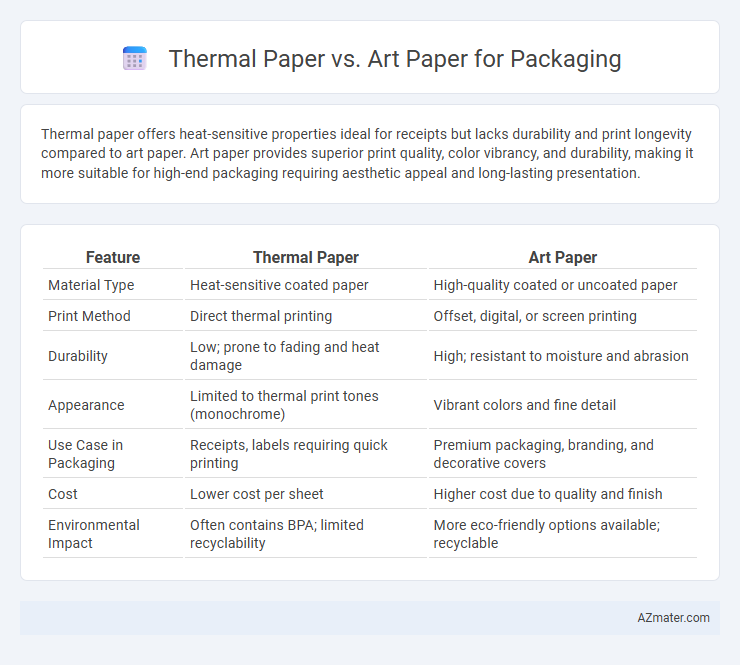Thermal paper offers heat-sensitive properties ideal for receipts but lacks durability and print longevity compared to art paper. Art paper provides superior print quality, color vibrancy, and durability, making it more suitable for high-end packaging requiring aesthetic appeal and long-lasting presentation.
Table of Comparison
| Feature | Thermal Paper | Art Paper |
|---|---|---|
| Material Type | Heat-sensitive coated paper | High-quality coated or uncoated paper |
| Print Method | Direct thermal printing | Offset, digital, or screen printing |
| Durability | Low; prone to fading and heat damage | High; resistant to moisture and abrasion |
| Appearance | Limited to thermal print tones (monochrome) | Vibrant colors and fine detail |
| Use Case in Packaging | Receipts, labels requiring quick printing | Premium packaging, branding, and decorative covers |
| Cost | Lower cost per sheet | Higher cost due to quality and finish |
| Environmental Impact | Often contains BPA; limited recyclability | More eco-friendly options available; recyclable |
Introduction to Thermal Paper and Art Paper
Thermal paper is a heat-sensitive material primarily used for printing receipts and labels, offering quick, cost-effective, and efficient printing without ink. Art paper, commonly used in packaging, features a smooth, coated surface ideal for high-quality, vibrant graphic designs and detailed printing. Both papers serve distinct purposes in packaging, with thermal paper emphasizing functionality and art paper enhancing visual appeal and brand presentation.
Key Differences Between Thermal and Art Paper
Thermal paper, coated with heat-sensitive chemicals, is designed primarily for printing receipts and labels, offering quick image development without ink, while art paper features a smooth, high-quality surface ideal for vibrant graphics and detailed packaging designs. Thermal paper typically has a thinner, more flexible composition, enhancing its suitability for short-term use, whereas art paper's durability and texture make it preferable for premium packaging requiring sturdiness and aesthetic appeal. Art paper often utilizes specialized coatings such as gloss or matte finishes that improve print clarity and color fidelity, contrasting with the heat-reactive layers found in thermal varieties.
Print Quality: Thermal Paper vs Art Paper
Thermal paper offers high-contrast, sharp print quality due to its heat-sensitive coating, ideal for quick, clear text and simple graphics in packaging labels. Art paper provides superior print quality with vibrant colors, fine details, and smooth finishes, making it suitable for high-end packaging requiring detailed images and premium aesthetics. While thermal paper excels in cost-effective, efficient printing, art paper delivers enhanced visual appeal and durability for brand presentation.
Cost Comparison: Which is More Affordable?
Thermal paper generally offers a more affordable option for packaging due to its lower production costs and elimination of ink requirements, making it ideal for high-volume printing such as receipts or labels. Art paper, while providing superior quality and a premium finish suitable for luxury packaging, involves higher material and printing expenses, increasing overall cost. For businesses prioritizing budget efficiency, thermal paper is the cost-effective choice, whereas art paper suits brands willing to invest in enhanced visual appeal and durability.
Durability and Longevity in Packaging
Thermal paper, commonly used for receipts and labels, offers moderate durability but tends to degrade quickly under exposure to heat, light, and moisture, limiting its longevity in packaging applications. Art paper, with its coated surface and superior fiber quality, delivers enhanced durability and resistance to environmental factors, making it better suited for long-term packaging needs. The choice between thermal and art paper significantly impacts product protection and shelf life, with art paper providing a more robust option for high-quality packaging.
Environmental Impact and Sustainability
Thermal paper, often coated with BPA or BPS chemicals, poses significant environmental concerns due to its non-recyclability and potential toxicity, making it less sustainable compared to art paper. Art paper, typically made from sustainably sourced fibers and recyclable without hazardous chemicals, supports eco-friendly packaging solutions by reducing waste and promoting biodegradability. Choosing art paper over thermal paper in packaging minimizes harmful environmental effects and aligns with sustainable material practices.
Customization and Design Flexibility
Thermal paper offers limited customization options due to its heat-sensitive coating, which restricts the use of vibrant colors and complex designs in packaging. Art paper provides superior design flexibility with a smooth surface that supports high-quality printing, allowing for a wide range of colors, finishes, and textures ideal for customized packaging solutions. Brands seeking visually appealing and highly customizable packaging typically prefer art paper over thermal paper to enhance product presentation and consumer engagement.
Best Applications for Thermal Paper
Thermal paper is ideal for packaging applications requiring quick, efficient printing of labels, receipts, and tags without the need for ink or toner, making it highly suitable for retail and logistics environments. Its heat-sensitive coating ensures fast, clear printouts that enhance operational speed and reduce production costs. Common uses include barcode labels, shipping tags, and point-of-sale receipts where durability and readability are crucial.
Ideal Uses of Art Paper in Packaging
Art paper excels in packaging due to its smooth surface and superior print quality, making it ideal for high-end product labels and luxury goods packaging where vibrant, detailed graphics are crucial. Its durability and resistance to moisture enhance product protection while maintaining a premium look, perfect for cosmetics, gourmet foods, and gift boxes. Unlike thermal paper, art paper supports various finishes like gloss, matte, or satin, providing versatile design options that elevate brand presentation.
Choosing the Right Paper for Your Packaging Needs
Thermal paper offers excellent print clarity and quick-drying properties ideal for receipts and labels requiring high durability and heat sensitivity. Art paper, with its smooth texture and superior color reproduction, is better suited for high-end packaging that demands premium aesthetics and detailed graphics. Selecting between thermal paper and art paper depends on the packaging's functional requirements, such as heat resistance and print quality, and its visual impact goals.

Infographic: Thermal paper vs Art paper for Packaging
 azmater.com
azmater.com